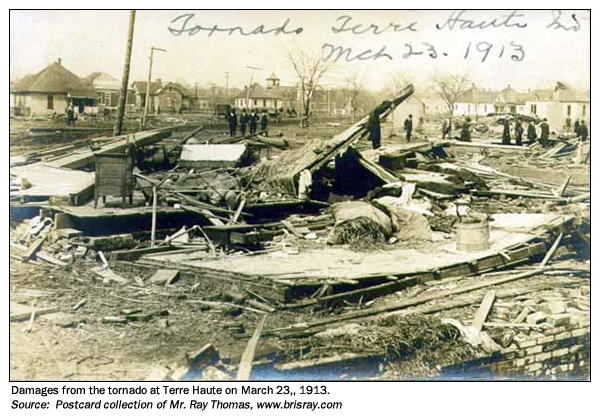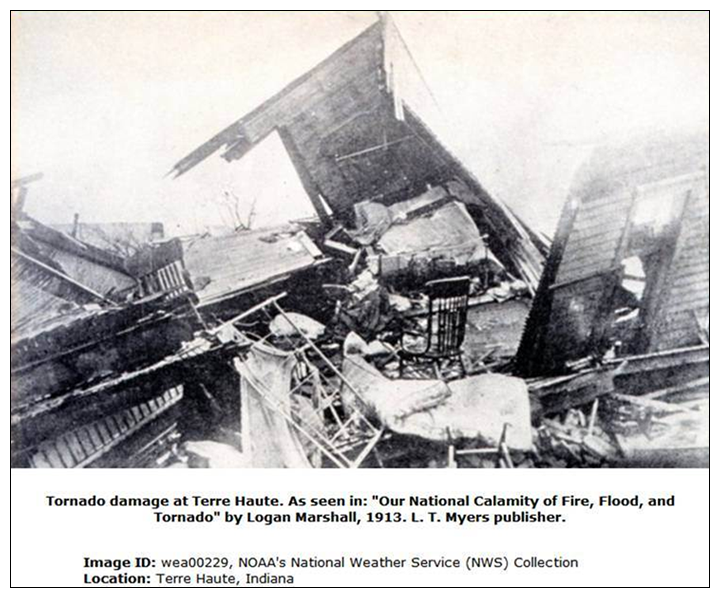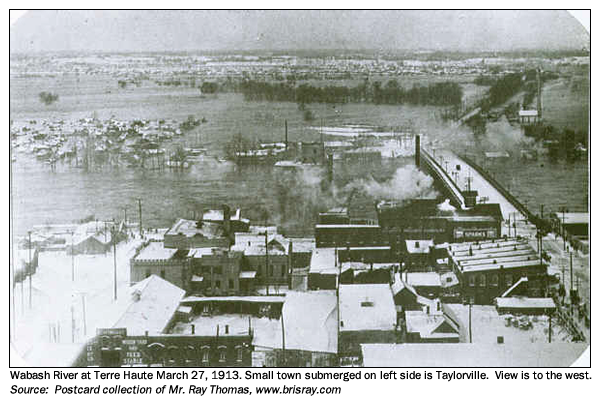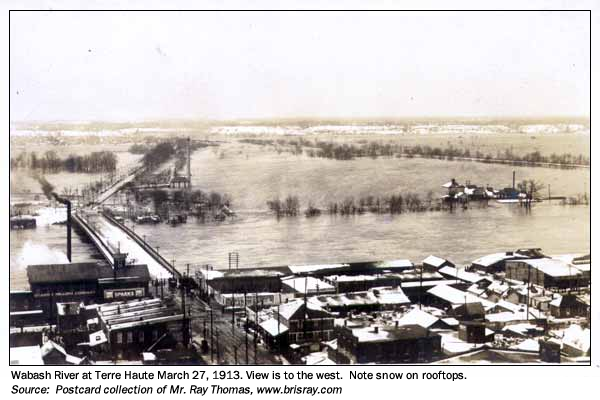The Great Flood of 1913
100 Years Later
Community Profiles: Terre Haute, Indiana
| River: | Wabash |
| Storm Total Rainfall: | 6.62" |
| Known Fatalities: | 20-25 from tornado on 3/23 |
Timeline
Two weather disasters descended on the Terre Haute area in the very early spring of 1913. First an F-4 tornado killed more than 20 people late in the evening of March 23rd and a record flood left the city in the dark four days later.
From “Flood on the Wabash River in March 1913” by W.R. Cade, U.S. Weather Bureau (USWB) Observer: "Early Sunday, March 23 the Wabash River at Terre Haute was at the 7-foot level" which is relatively normal for March.
By Monday morning rainfall amounts in the Wabash Valley upstream of Terre Haute ranged from 1 inch at Terre Haute to nearly 4 inches at Bluffton in the northern-most portion of the valley. This heavy rain caused the river to rise at a record-breaking rate. Flooding was in progress at all locations upstream of Terre Haute and near the 16-foot flood stage at Terre Haute.
The heavy rain continued Monday and the amounts on Tuesday morning were equally as large as those the previous morning, and ranged from 2 to 3 inches. The river continued to rise very rapidly. The account of what happened on the 24th and 25th in the Taylorville and West Terre Haute areas immediately west of Terre Haute: "When the river at Terre Haute reached a stage of 19 feet the residents of a little settlement of about 400 inhabitants, known as Taylorville, on the west side of the river, began to leave their homes. Within a day after they left their houses the entire place was submerged. The people living in Taylorville and in West Terre Haute were advised through the newspapers by the local office to prepare for a high river which was fast approaching the city. West Terre Haute, also on the west side of the river, suffered considerable damages during the flood. For the first time in the history of this town, which has a population of 4,000, the water covered its main street, and was several inches high on the floors of the stores and other business houses on this street."
A break in the rainfall occurred during the day on Tuesday because only slight amounts of rain were reported on Wednesday, March 26, but the river continued rising. About another half of an inch of rain fell over the valley during the 24 hours ending March 27.
Impacts
What follows are the conditions and the tragic account of the March 1913 tornado as described by the Terre Haute Weather Bureau official in charge:
"On the evening of March 23, 1913, a tornado passed through the south end of Terre Haute, less than 2 miles south of the weather station. The tornado crossed the Wabash River and entered the city at Gardentown, about 2 miles south of the main street of Terre Haute. From this place it swept across the city in a northeastelry [sic] direction, Twenty-fifth and Hulman Streets being the eastern limit in this city of the zone of destruction. It traversed the city in less than two and a half minutes, during which time 300 houses were demolished or damaged, 250 persons injured, and 21 lives lost. The
 width of the area of greatest devastation was about 200 yards, but property was damaged on each side of this track for 500 yards. Evidences of the violent 'explosive' force of the tornado were everywhere. On the outer limits of the zone of destruction one would see here and there a window blown out or a part of a wall or roof torn out. On approaching the path over which the center of the disturbance passed it would be seen that entire walls were forced outward or a whole roof lifted off. In the zone of greatest destruction the demolition was complete. Here entire houses were demolished, and it was the exception to see a wall standing.
width of the area of greatest devastation was about 200 yards, but property was damaged on each side of this track for 500 yards. Evidences of the violent 'explosive' force of the tornado were everywhere. On the outer limits of the zone of destruction one would see here and there a window blown out or a part of a wall or roof torn out. On approaching the path over which the center of the disturbance passed it would be seen that entire walls were forced outward or a whole roof lifted off. In the zone of greatest destruction the demolition was complete. Here entire houses were demolished, and it was the exception to see a wall standing.
"On the morning of March 23 the temperature ranged from 38° to 55°, and rain was continuous from 4:55 a.m. to 12:40 p.m. With the stopping of the rain the temperature rose rapidly, reaching 72° at 5 p.m., and the weather was exceedingly oppressive. At 8 p.m. rain began again, with a thunderstorm. At 9:20 p.m. the rain became heavy and fell at the rate of 0.10 inch in five minutes. It continued at this rate for 25 minutes. During this heavy fall of rain the lightning was most vivid. At 9:45 p.m., the time the tornado was crossing the city, the pressure went down and up 0.10 inch in a few minutes.
"I have talked with several persons who were in the tornado, and saw the funnel-shaped cloud sweeping along near the ground and house after house crumble as it passed over them. The roar which accompanied the passage of the cloud deadened all other sounds. One observer stated he did not hear his house fall while standing on the street within 25 yards of it. Some of the freakish effects of the whirlwind reported were: One woman had chickens defeathered; another living just on the border of the storm had bed clothing drawn off her through the fireplace; in one house the linoleum was raised off the floor; in another, a baby was lifted out of its bed, carried a square and laid down without injury; and toothpicks were found driven into the hardwood of a buffet on which they rested."

Below is the USWB account of what happened in Terre Haute beginning on the 26th as the Wabash River rose to the March 1913 crest:
"By Tuesday morning, March 25, the water had driven the Taylorville people from their houses, and the next day the lower parts of West Terre Haute were inundated. It was on this day, March 26, that the river began its work of destruction on the Terre Haute side. The water, gas, electric, and other plants, including four large distilleries, along the river fought the rising water with sandbags, pumps, and other means. On the evening of March 26 a levee north of Terre Haute broke and a large section of the north end of town was covered with a foot or two of water.

"The river stage on Thursday morning, March 27, was 31.2 feet, and the water was rising slowly. A few hours after this reading the crest of the flood was reach, 31.3 feet. The water remained at this height for several hours and then began to slowly recede. At 8 a.m., this date, the city gas plant shut down, and the electric plant discontinued operations about 45 minutes later. The water had been bravely fought at these places, but when the river reached 31 feet it was necessary to abandon further efforts in this direction.
"Of course, with the shutting down of the electric plant, the street-car service of the city was stopped, and on the night of March 27 the city was wrapped in darkness. Very few business houses generated their own electricity, and business on this night was conducted in candle and lamp light. People walking along the main street of the city carried lanterns, and the streets in the resident parts of town were illuminated only by the faint beams from a candle or a lamp coming through an open window. The city was without electricity until early in the morning of the 28th, and gas was not supplied until nearly 24 hours later.

"After the water reached the 27-foot stage the city was practically cut off from the rest of the country. Railroad bridges were rendered unserviceable, and the telegraph companies would not promise to get a message off in any direction. The new bridge connecting Terre Haute with the town of West Terre Haute, on the other side of the river, was closed to traffic for two days, March 28 and 29. However, this bridge sustained only slight damage. On the west side of the river, the Vandalia and Big Four tracks were under water for a distance of a mile or more, and considerable damage was done railroad property in this place.
"Fortunately, the city was not afflicted as were some other places on the river in having the water cut off. While the water company could not keep its water up to the standard, it did not find it necessary to close down.
"The damage, inconvenience, and suffering resulting from the flood at Terre Haute, was experienced at all other places along the river. At Logansport, La Fayette [sic], and Clinton bridges were washed away. At most places the water, gas, and electric plants were stopped, which, coupled with the other afflictions that came upon the people as a result of the flood, made the situation most acute."
Flood Protection Measures
Four Corps of Engineers reservoirs (JE Roush, Salamonie, Mississinewa and Cecil M. Harden) provide combined flood control benefits for 19% of the drainage area upstream of Terre Haute. Flood crests have been reduced to some degree because of these upstream flood control reservoirs.
To update information about the March 1913 tornado and flood stories of Terre Haute, contact Al Shipe by e-mail al.shipe@noaa.gov.

